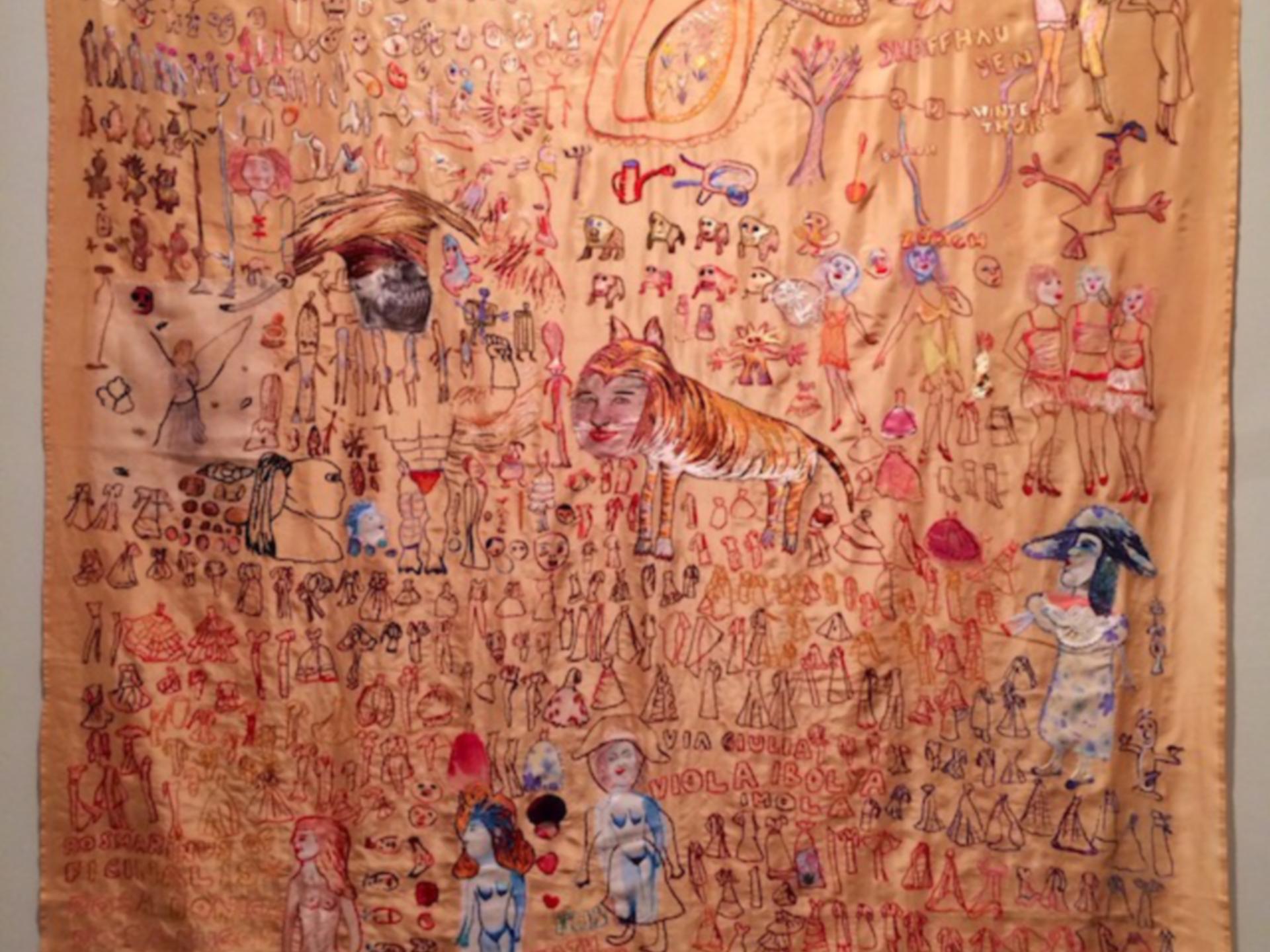01. Hybrid Language: The Interstitial Stitches of Anna Torma’s Embroideries
Essay by Anne Koval
Koval’s essay, which I discovered during a research visit to Camberwell Library, explores the textile practice of Hungarian-Canadian artist Anna Torma through the lens of interstitiality – a concept that frames identity as fluid, negotiated, and relational rather than fixed. Koval further positions Torma’s practice as gathering of familial, cultural and remembered languages, bringing together materials and gestures rooted in Hungarian popular and folk heritage.
The Interstitial Space
According to Koval (2020), social theorist Homi K. Bhabha defines the interstitial space as one shaped by the ‘overlap, and displacement of domains of difference’ – a space where identity is not fixed, but continually negotiated. Within this framework, Torma’s practice inhabits a zone of flux, where categories such as insider and outsider, contemporary and traditionalist, feminist and post-feminist coexist. Through remembered and fragmented materials and transformative gestures like stitching, embroidery, and appliqué, Torma navigates the in-between as a lived, material reality.
This notion of the interstitial directly informs my own practice. I work with materials such as glass, which themselves embody interstitial qualities through their dual nature, simultaneously transparent and reflective, fragile and enduring, intimate and public, personal and collective. Alongside this, I weave fabrics of clay and strands of my own hair, using them as embodied threads that trace memory through presence. These hybrids resist singular definitions; instead, they inhabit an in-between reality, connected to multiple places and temporalities, existing as both and neither.
The Interstitial Space
According to Koval (2020), social theorist Homi K. Bhabha defines the interstitial space as one shaped by the ‘overlap, and displacement of domains of difference’ – a space where identity is not fixed, but continually negotiated. Within this framework, Torma’s practice inhabits a zone of flux, where categories such as insider and outsider, contemporary and traditionalist, feminist and post-feminist coexist. Through remembered and fragmented materials and transformative gestures like stitching, embroidery, and appliqué, Torma navigates the in-between as a lived, material reality.
This notion of the interstitial directly informs my own practice. I work with materials such as glass, which themselves embody interstitial qualities through their dual nature, simultaneously transparent and reflective, fragile and enduring, intimate and public, personal and collective. Alongside this, I weave fabrics of clay and strands of my own hair, using them as embodied threads that trace memory through presence. These hybrids resist singular definitions; instead, they inhabit an in-between reality, connected to multiple places and temporalities, existing as both and neither.
Gathering
A particularly resonant work discussed in the essay is Vanitas I (2011), in which Torma constructs an imaginary world drawn from memories of her childhood – flower names, paper dolls, fashion plates, comic book villains – layered through soft collage and applique techniques. These visual and material fragments function as acts of inclusive gathering, bringing together communities, memories and domestic practices (Koval, 2020). A way of advocating for the overlooked and the fragile, embodying a language of relational memory, care, and an ongoing search for belonging within the context of resettlement.
This framework informs my own research, in which I collaborate with elements like braids, satin ribbons, half-forgotten embroidery motifs, carraway seeds, weave patterns, and horsehair to reconnect with my familial and Hungarian folk heritage. These materials and gestures operate as intimate, embodied forms of gathering, both emotional and cultural, centring my family as both subject and source.
A particularly resonant work discussed in the essay is Vanitas I (2011), in which Torma constructs an imaginary world drawn from memories of her childhood – flower names, paper dolls, fashion plates, comic book villains – layered through soft collage and applique techniques. These visual and material fragments function as acts of inclusive gathering, bringing together communities, memories and domestic practices (Koval, 2020). A way of advocating for the overlooked and the fragile, embodying a language of relational memory, care, and an ongoing search for belonging within the context of resettlement.
This framework informs my own research, in which I collaborate with elements like braids, satin ribbons, half-forgotten embroidery motifs, carraway seeds, weave patterns, and horsehair to reconnect with my familial and Hungarian folk heritage. These materials and gestures operate as intimate, embodied forms of gathering, both emotional and cultural, centring my family as both subject and source.
Bibliography
Koval, A. (2020) ‘Hybrid Language: The Interstitial Stitches on Anna Torma’s Embroideries’ in J. Amos and L. Binkley (eds) Stitching the self: Identity and the needle arts. London: Bloomsbury Publishing, pp. 141 – 154.
Koval, A. (2020) ‘Hybrid Language: The Interstitial Stitches on Anna Torma’s Embroideries’ in J. Amos and L. Binkley (eds) Stitching the self: Identity and the needle arts. London: Bloomsbury Publishing, pp. 141 – 154.
